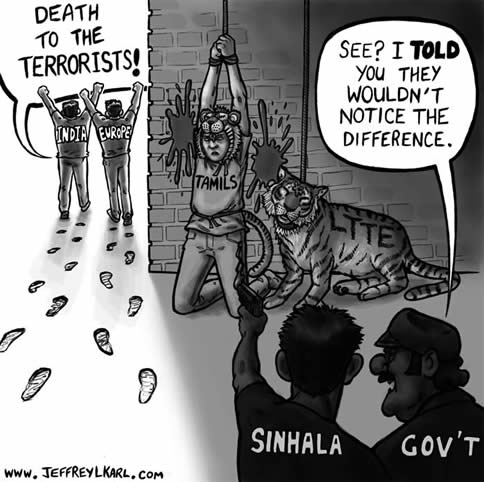Ilankai Tamil Sangam30th Year on the Web Association of Tamils of Sri Lanka in the USA |
|||
 Home Home Archives Archives |
To Catch a Tigerby Robert D. Kaplan, The Atlantic Monthly, July 1, 2009
Sri Lanka's brutal suppression of the Tamil Tigers offers an object lesson in how to defeat an insurgency. Or does it? Though it was only a one-day news story in the United States, a momentous event occurred last spring, with worldwide military significance. After 26 years of heavy fighting, the Sri Lankan government decisively defeated an ethnic insurgency, killing all of its top leadership, whose bodies were displayed on national television. Massive victory parades followed. The Tamil Tigers were no ordinary insurgency. Built on the ethnic hatred of the minority Hindu Tamils against the majority Sinhalese Buddhists, the movement was among the best organized and most ruthless to have emerged anywhere since the Second World War. The Tigers boasted their own air force and navy to go along with their unconventional ground troops. They helped pioneer the use of suicide bombers. (Recall that it was a female Tiger suicide bomber who killed Indian Prime Minister Rajiv Gandhi in 1991.) They regularly embedded their fighters among noncombatants, using them as human sheilds. In other words, they were as organized and heartless as any insurgent group in Iraq or Afghanistan. The Tamil Tigers, moreover, had a brilliant, charismatic leader by the name of Vellupilai Prabakharan, who was venerated by many ethnic Hindu Tamils to the same extent that radical Muslims have venerated Osama bin Laden. His following was cult-like and was largely responsible for the war that killed 70,000 people since 1983, in an island of only 22 million people. Compare that to the deaths of 3,000 in the World Trade Center out of a population of 300 million in the United States. So when the Sri Lankan government displayed Prabakharan's body on television last May, it represented the culmination of a counterinsurgency campaign that the U.S. could only dream about. Clearly, then, the U.S. Army and Marine Corps should be studying the Sri Lankan civil war for valuable lessons about how to win a counterinsurgency, right? Actually—no. In fact, there are no useful pointers to be gleaned from the Sri Lankan government’s victory. The war was won using techniques like the following, which the United States could and should never employ. The insurgents are using human shields? No problem. Just keep killing the innocent bystanders until you get to the fighters themselves. There is no comparison between the few civilians that have been killed by American Predator drones in the Afghanistan-Pakistan border region, and the many that were killed by the Sri Lankan government. The Americans have carefully targeted select al-Qaeda members and, in the process, killed a few—at the most, dozens—of civilians among whom the fighters were surrounded. By contrast, the Sri Lankan military indiscriminately killed large numbers of civilians—as many as 20,000 in the final months of fighting, according to the United Nations. Bad media coverage is hurting morale and giving succor to the enemy? Just kill the journalists. That's what the Sri Lankan authorities did. Precisely because insurgencies are unconventional, there are no easy-to-follow infantry advances and retreats, so the media holds the power to shape a narrative for the public. Aware of the need for a compliant media to aid the war effort, the Sri Lankan government struck fear into the ranks of journalists. There were hundreds of disappearances of top opinion leaders. “Murder has become the primary tool whereby the state seeks to control the organs of liberty,” wrote journalist Lasantha Wickramatunga in a self-penned obituary that anticipated his own assassination in early 2009. Sources told me that he was killed by having iron rods with sharp points driven through his skull. “If Lasantha, with all of his connections, could be killed in broad daylight, then they could do this to anybody,” one journalist in the capital of Colombo told me. This journalist told me stories about reporters being beaten black and blue, leading to an atmosphere of extreme self-censorship—“the worst and most insidious kind.” Another journalist told me: “Lasantha’s fate really scared us. People like me decided it was more important to stay alive than to report the news.” No journalist I met in Colombo was willing to cross the line and publicly attack the government. The international community disapproves of your methods and cuts off military aid because of the human rights violations you've committed? Again, no problem. Get aid from China, whose assistance comes without moral lectures. That’s just what the Sri Lankan Government did. In return, the Chinese got the right to help construct a deep water port in Sri Lanka, close to world shipping lanes. So is there any lesson here? Only a chilling one. The ruthlessness and brutality to which the Sri Lankan government was reduced in order to defeat the Tigers points up just how nasty and intractable the problem of insurgency is. The Sri Lankan government made no progress against the insurgents for nearly a quarter century, until they turned to extreme and unsavory methods. Could they have won without terrorizing the media and killing large numbers of civilians? Perhaps, but probably not without help from the Chinese, who, in addition to their military aid, gave the Sri Lankan government diplomatic cover at the UN Security Council. These are methods the U.S. should never use. But the fact that this is what it took for the Sri Lankan government to subdue the Tamil Tigers makes clear just what a hard grind lies ahead for the U.S. in Afghanistan |
||
|
|||
